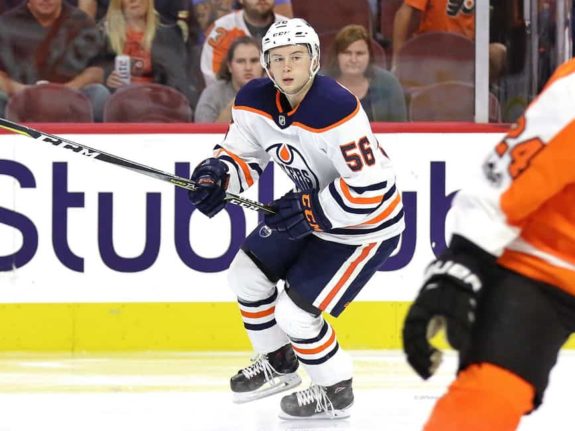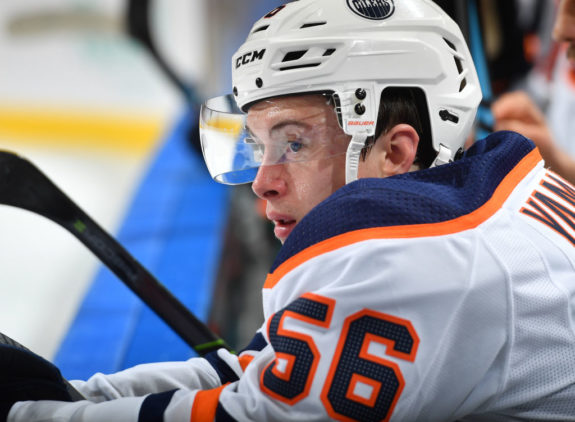With training camp approaching very soon and players already back on the ice, the Edmonton Oilers inked their last remaining restricted free agent (RFA) to a deal. Kailer Yamamoto agrees to a one-year $1.175 million extension that allows the team to hold his rights still when the season is over.
This is an excellent deal for the Oilers in a flat cap as they are pushing the line with available cap space. This is not a bad move by Yamamoto either, as he had a down year and will be gambling on himself to perform up to the level he was at when he joined the team in a full-time role in 2019-20.

At this age, it can be difficult to judge the trajectory of a player, as off-years and breakout seasons can occur at any time. Two trial runs with the Oilers in 2017-18, and 2018-19 saw Yamamoto struggle with five points in 26 games. He needed time to develop a little more. But once he did, he came out flying with 26 points in 27 games in his return in 2019-20. Last season was a little tougher to find the back of the net and contribute points, but the effort was still there. For a top-six forward with a pretty tight hold on the right side beside Leon Draisaitl and Ryan Nugent-Hopkins, this contract is going to prove very lucrative for the Oilers.
Close Comparisons
Jesse Puljujarvi
You don’t have to look too far to find a good comparable to Yamamoto, and his name is Jesse Puljujarvi. Drafted the year prior in the first round, there may have been more pressure and less time to develop. Despite that, they both find themselves playing in the Oilers’ top-six alongside two of the best centremen in the game.
Both are willing to go to the dirty areas and retrieve pucks. They are excellent cheap compliments to the highly skilled players they play with. After signing for $1.175 million, Yamamoto and Puljujarvi are on the books for the same price tag next season. Both players are comfortable in their roles and should only get better as they acclimate more to the NHL level and approach the prime of their careers.
It will be fun and interesting to watch how each performs in 2021-22 and what deals they will be offered at the end of the year, as they are both RFAs once again.
Casey Mittelstadt
Line-mates at the 2018 World Juniors, both Yamamoto and Mittelstadt led their team and showed great promise for the future. Given where they were drafted, they’ve taken a bit longer than expected to get going at the NHL level. Mittelstadt was taken at number eight and Yamamoto 22nd overall in the 2017 draft. Stat-wise, for a player that has out-performed his counterpart, Yamamoto’s one-year deal looks like a steal compared to Mittelstadt, whose deal is very fair.
Suppose Yamamoto levels out and performs somewhere in-between his first two seasons. We could see a deal with longer-term and more money than Mittelstadt is making (3 x $2.5m). The opportunity is there with his projected line-mates and boosted by his compete level every night, even though the bounces didn’t go his way last season.
Drake Batherson
Drafted later in the 2017 draft, Batherson’s stats are very comparable to Yamamoto’s. Both able to score and make plays, they play high in the lineup. With only six games separating them, Batherson has 23 career goals, while Yamamoto has 20. Batherson has the advantage in points by one but take into account that he spent last season on the Senator’s first line and on the top power-play unit. Yamamoto only spent part of the 2019-20 season on the top line, as Connor McDavid was injured, and the whole line had to move up.
The Ottawa Senators are a rebuilding team with tons of cap space to spend like the Buffalo Sabres. But unlike the Sabres, the Senators spent money to keep players around. They locked up Drake Batherson to a six-year deal worth $4.975 million per season. For a player with under 100 games, this was a gamble. The way the cap situation is in Edmonton, I still could not see Yamamoto earning as much unless he exceeds 55-60 points in an entire season.

Even other players who have shown similar abilities to Yamamoto aren’t signed to as team-friendly deals as he is. Examples include Maxime Comtois at $2,037,500 for two more seasons and Eeli Tolvanen with a contract of three years at $1.450 million. Joel Farabee, the youngest of the bunch, is also about to earn $5 million average annual value (AAV) in 20202-23 coming off his entry-level contract with almost identical stats as Yamamoto to this point in their careers (From ‘OILERS NOTES: What does Kailer Yamamoto get after Joel Farabee signing?,’ Edmonton Journal, 9/3/21).
Yamamoto will be betting that results will come again after an unlucky year in 2020-21. This short-term contract allows him to show the team that he is worth signing to a lengthy contract and bigger money. He also looks to earn special teams minutes to increase his value. As his contract looks pretty nice for the Oilers at the moment, it could benefit Yamamoto greatly down the line.